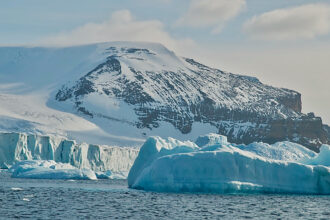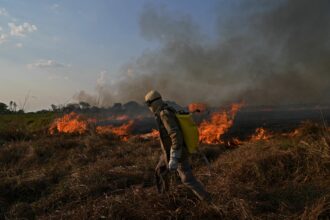With the planet warming by a fraction of a degree every few years, glaciers melting away in a trickle and sea level rising two inches per decade, global warming sometimes seems to be happening at a slow and steady pace.
But measured against Earth’s long-term geological history, those changes are dramatic, and a trail of ancient clues in rocks and ice distributed from pole to pole document even more abrupt changes in the past, including a warning about the potential for disruptive shifts in the future.
New research led by Oregon State University climate scientists published this week in Nature analyzed the chemistry of ice cores from Greenland and Antarctica to track global temperature and precipitation, as well as atmospheric changes, about 17,000 years ago, when huge swarms of icebergs broke off the coastal edge of the Laurentide Ice Sheet that covered much of North America.
When the ice surged into the Atlantic Ocean through the Hudson Strait, it triggered abrupt shifts in ocean currents, monsoon rainfall and drought patterns, as well as atmospheric concentrations of methane, but some of the climate impacts didn’t happen where and when they might have been expected.
For example, the new study shows that the abrupt Arctic changes barely registered on the nearby Greenland Ice Sheet, but instead caused rapid warming in Antarctica, at the other end of the globe, said lead author Kaden Martin, a fourth-year doctoral candidate working at Oregon State University’s Ice Core Lab.
“We know these events have a massive global impact, but we don’t see it in Greenland,” he said. “The same physics apply today.”
Lake and ocean sediments, as well as tree rings, show the climate was very unstable at the end of the last ice age, 25,000 to 15,000 years ago, with sudden and geographically varied swings between warm and cold periods known as Heinrich and Dansgard-Oeschger events, perturbations that may have only lasted 1,000 years.
At times, Northern Hemisphere ice sheets retreated in dizzying spurts of nearly half a mile per day, and sea level may have risen 10 times as fast as it is currently, perhaps as much as 15 feet in a single century.
But Greenland didn’t seem to notice the surge of icebergs into the ocean around it 17,000 years ago.
The lack of a response in Greenland is “really remarkable,” said co-author Christo Buizert, also a climate scientist at Oregon State University.
He said the finding reminded him of a Sherlock Holmes mystery called Silver Blaze, in which a dog that did not bark when it should have was the clue to solving the case.
“We’re trying to understand these really complex events,” he said. “They’re clearly global. The whole world is doing something, and the fact that Greenland is doing nothing is sort of like the dog that didn’t bark.”
“It has to be important,” he said. “A whole big part of the ice sheet just falls into the ocean, and Greenland is sitting right next to it and it just doesn’t care. This really changes how we look at these massive events in the North Atlantic. It’s puzzling that far-flung Antarctica responds more strongly than nearby Greenland.”
What Happens at One Pole Affects the Other
There is a well-known pole-to-pole connection via ocean currents that transport warm and cold water in both directions deep down and at the surface in a kind of slow-moving ocean conveyor belt, known as the Atlantic Meridional Overturning Current, or AMOC. In general, large amounts of cold, fresh water entering the ocean from melting ice slow that current. Those are changes that play out over centuries and millennia, and recent research shows it’s happening right now.
But when the scientists saw how quickly the temperatures in Antarctica warmed in response to sharp changes in the Arctic, they realized there must be something else at work. They suggested there’s an atmospheric climate connection that operates on a much faster timescale. That’s a dynamic that probably has implications for climate change today, because rapid warming in Antarctica would accelerate ice sheet melting and sea level rise.
Pinpointing the atmospheric connection will require more research, but drivers could include cycles of equatorial Pacific sea surface temperatures known as El Niño and La Niña, as well the shift of an area called the Intertropical Convergence Zone, marked by near-constant rising of moist, tropical air that spawns thunderclouds and rainstorms.
“We call that the thermal equator,” said Martin. “The ITCZ is the place on Earth where heat is transported in the atmosphere equally to the north and to the south.”
That zone shifts seasonally each year as the tilt of the Earth’s axis changes relative to the sun. During the Northern Hemisphere summer, it moves to export some of that heat buildup to the south, he added.
But the convergence zone can also shift more long-term in response to other big changes in the climate system, and both scientists said they suspect that sort of shift may be implicated in the Antarctic warming they documented in response to the disintegration and mobilization of the Arctic ice sheets.
Rainfall Patterns And Methane Emissions Affected
That same shift has serious implications for global rainfall patterns, and in a related effect also identified by the study, on methane emissions from natural sources. Tropical wetlands are by far the single biggest source of planet-warming methane already, and if rainfall patterns shift enough to change the size and configuration of those wetlands, it would affect methane levels.
A long-term shift of the Intertropical Convergence Zone to the south would also push rainfall away from Northern Hemisphere land areas and deeper into the Southern Hemisphere, which has much less land, so more rain would fall into the ocean.
Buizert said a southward shift of the ITCZ also pushes another important belt of winds, the Southern Hemisphere westerlies, closer to Antarctica, which could drive more warm water toward the already vulnerable ice shelves.
The new paper is “a thorough piece of work that puts together a lot of new data and existing data in an extremely careful way,” said Sune Olander Rasmussen, an ice and climate physicist at the Niels Bohr Institute at the University of Copenhagen, who was not involved in the study.
“I think it’s crucial in disentangling how climate change propagates,” he said. “This is not just a description of what happened.They go deeper into mapping out which different mechanisms are at work, and sometimes it’s several mechanisms on top of each other, affecting different regions at different speeds.”
Keep Environmental Journalism Alive
ICN provides award-winning climate coverage free of charge and advertising. We rely on donations from readers like you to keep going.
Donate NowThe research is another step in understanding how the Earth’s polar regions are connected by climate, which potentially can help scientists more accurately project how the whole system will react to human-caused warming, said Alan Condron, who studies abrupt climate change at the Woods Hole Oceanographic Institution.
Condron said his research group is currently trying to model how the effects of a catastrophic collapse of the West Antarctic Ice Sheet may propagate across the rest of the planet. If the new paper’s suggestion of an atmospheric connection between the poles holds up, it could mean that a big meltdown in Antarctica would not just cause more sea level rise, but could also lead to a rapid temperature spike in the Northern Hemisphere, he said.
Anything that helps increase understanding of the global climate system will help communities adapt to global warming impacts, co-author Buizert said.
“If you warm or cool one part of the planet, you know that the heat has to go somewhere, and it has to come from somewhere, so it’s a balancing act,” he said.
Understanding those dynamics is important, because if some of the changes observed in the past happen again, “we are in trouble,” he said.













